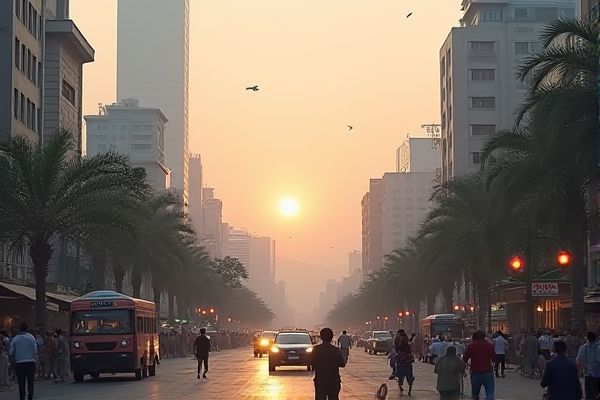
Cost of living in India: Affordable housing options available. Low transportation costs. Varied food prices by region. Utilities relatively inexpensive. Healthcare is cost-effective. Education costs are competitive. Entertainment and leisure are budget-friendly. Price disparity between rural and urban areas. Import goods can be expensive. Currency exchange impacts overall cost.
Affordable housing options available.
In India, affordable housing options include government initiatives such as the Pradhan Mantri Awas Yojana (Urban and Gramin), Rajiv Gandhi Awas Yojana, and state-specific schemes like the Delhi Development Authority Housing Scheme and Tamil Nadu Housing Board Schemes, which offer subsidies, low-interest loans, and discounted housing units to various income groups. To explore more about these initiatives and understand their impact on housing accessibility, visit the comprehensive overview provided by Affordable Housing in India.
Low transportation costs.
In India, transportation costs are relatively low, with a monthly bus or transport pass averaging Rs600, a single bus ticket costing Rs18, and a 30-minute taxi ride costing Rs30. Gasoline prices are around Rs65 per liter, making public and private transportation affordable for many. To explore more about the cost of living in India, visit the Wise Blog where you can find comprehensive insights and details.
Varied food prices by region.
Food prices in India vary significantly across different states, with prices for typical food items often doubling or trebling from one state to another. The main determinants of these price differences include limited access to supply from other states and the extent of local production, with richer states generally having higher consumer prices. For further insights into these dynamics, you can explore the detailed analysis on Food Price Differences Across Indian States. Understanding these patterns is crucial for addressing supply chain efficiencies and economic planning within the region.
Utilities relatively inexpensive.
In India, utilities including electricity, water, and garbage disposal are quite affordable, typically spanning from Rs2,000 to Rs10,000 monthly, influenced by the house size and number of residents. Additionally, internet costs contribute modestly to living expenses, generally accumulating to less than Rs1,500 per month. For more in-depth information, refer to the detailed insights from the Cost of Living in India article, where various aspects of living expenses in India are thoroughly explored.
Healthcare is cost-effective.
Healthcare in India is significantly cost-effective, with medical treatments, medications, and surgeries costing a fraction of what they do in developed countries, making India a global hub for Medical Tourism and offering high-quality care at affordable prices.
Education costs are competitive.
In India, the costs associated with education are both highly competitive and rapidly increasing. The fees for high school can vary greatly, ranging from Rs. 80,000 to Rs. 3 lakhs per annum. The situation is even more striking in higher education, where the expenses for a four-year degree may potentially escalate to Rs. 40 lakhs over the next 15 years, driven by a consistent 6% inflation rate. To navigate these financial challenges, exploring various [Children Insurance Plans](https://www.hdfclife.com/children-insurance-plans/rising-cost-of-education-in-india) is becoming crucial for families aiming to secure their children's educational future.
Entertainment and leisure are budget-friendly.
Entertainment and leisure in India are generally budget-friendly, with dining out and traditional activities like cinemas remaining affordable, although some modern amenities like fitness clubs and international events have seen price increases. However, overall entertainment costs are still lower than in many Western countries, making India an attractive destination for leisure activities. For a more detailed understanding of the Cost of Living in India, visitors and expatriates can explore further insights and guidelines available online.
Price disparity between rural and urban areas.
The cost of living in India varies greatly depending on the region, with urban areas witnessing significantly higher expenses compared to rural locales. In cities like Mumbai and Delhi, average living expenses can range from Rs30,000 to Rs60,000 per month, highlighting the stark contrast to rural areas where costs are notably lower. For instance, a typical household in rural Bihar might spend around Rs3,735 per month. For a detailed understanding of these differences, the Cost of Living in India guide provides comprehensive insights into these living cost disparities across various regions.
Import goods can be expensive.
Import goods from India can be expensive due to various costs including tariffs, shipping fees, and duties, which are determined by the type and value of the goods being imported. Additional factors such as weather conditions, the need for specialized transport (e.g., refrigerated transport for crustaceans), and insurance costs can also increase the overall expense. For comprehensive guidance on navigating these complexities, visit the USA Customs Clearance website.
Currency exchange impacts overall cost.
Currency exchange rates significantly impact the cost of living in India, as fluctuations in the rupee's value against currencies like the US dollar, British pound, and euro can lead to increases in household budgets. This can particularly affect food prices and overall living expenses. As discussed in the EcoWrap Report, these changes underscore the critical importance of managing exchange rate volatility to maintain economic stability and protect consumer spending power in the region.
